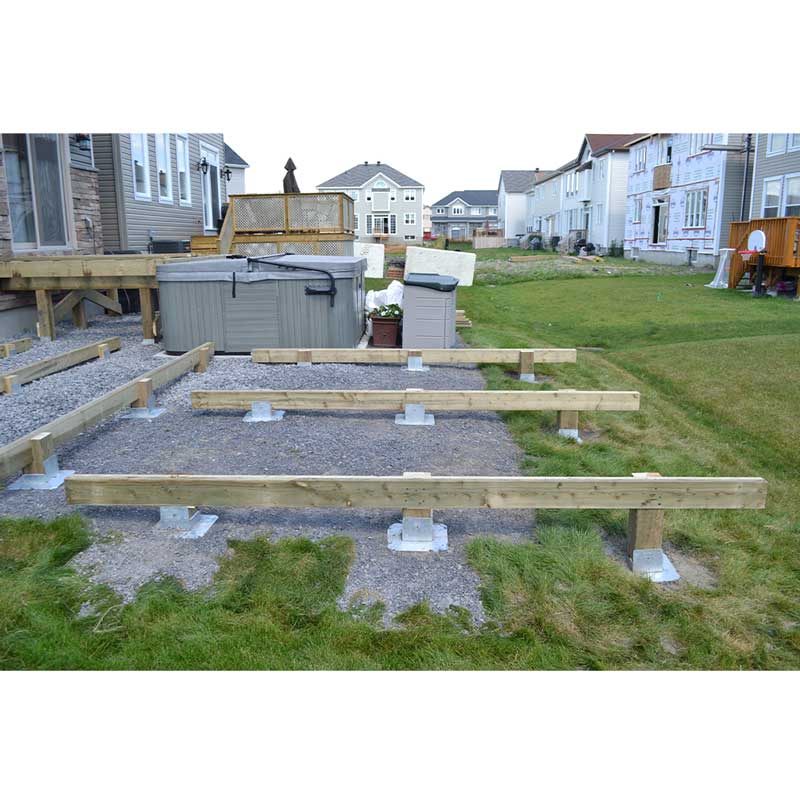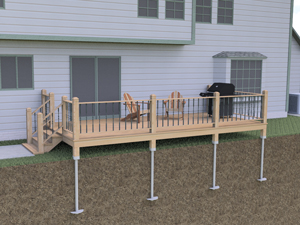Structure from the Ground Up: The Ultimate Overview to Designing and Installing Deck Footings
Professional Tips for Setting Up Deck Footings to Support Your Outdoor Space
When it comes to developing a deck, one of the most essential aspects to consider is the installment of proper footings. These footings are the foundation upon which your outside area will relax, providing stability and support for years to come. What exactly does it take to install deck footings appropriately?
Value of Proper Deck Grounds
Appropriate deck footings are vital for making sure the stability and longevity of your outdoor room. When building a deck, it is vital to focus on the foundation on which it will certainly relax. Deck footings offer the needed support for the whole framework and help distribute the weight equally - Deck Footings. Without strong and appropriately set up grounds, your deck might end up being unpredictable, leading to safety risks and pricey fixings.

Along with security, correct deck footings also add to the long life of your exterior room (Deck Footings). Footings that are designed and created to hold up against the components and dirt conditions in your location will aid avoid the deck from shifting or settling with time. By guaranteeing the footings are correctly sized and installed, you can reduce the threat of damages to the deck structure, extending its life-span and lowering the requirement for costly fixings or replacements

Choosing the Right Sort Of Footings
When selecting the ideal type of footings for your deck, it is necessary to consider factors such as soil conditions, local building ordinance, and the total layout of your outdoor area. The type of footing you choose will play an essential duty in making certain the security and durability of your deck.
One typical kind of ground is the concrete ground. Concrete grounds appropriate for most soil problems and give excellent support for decks. They are typically mounted listed below the frost line to avoid shifting and settling due to freezing and thawing cycles. One more option is helical piers, which are optimal for locations with unsteady soil or high water tables. These piers are screwed into the ground and offer strong support for the deck.
In many cases, you might need to use specialized grounds, such as heap grounds or deep foundations, if you are developing a multi-level or large deck. These grounds are made to distribute the weight of the deck over a larger area, ensuring security and protecting against working out or sinking.
Before choosing a sort of footing, it is vital to consult local building ordinance and laws to ensure conformity. Additionally, think about the design and intended use of your outdoor area. Variables such as the size, form, and load-bearing demands of your deck will affect the sort of footing that is most ideal.
Preparing the Ground for Footing Installation
To correctly prepare the ground for footing installment, it is crucial to analyze the soil conditions and take needed actions to ensure security and toughness of the deck. The primary step is to dig deep into the area where the grounds will be mounted. The depth of the excavation will certainly depend upon the frost line in your area and the particular needs of the deck layout. It is essential to get rid of any plant life, rocks, or particles from the excavation to make certain a strong structure.
When the location has been dug deep into, the following action is to compact the soil. This can be done using a plate compactor or by utilizing a hand tamper. Condensing the dirt assists to eliminate any type of spaces or air pockets, which can lead to working out and instability in time.
After compacting the soil, it is essential to lay a layer of gravel or smashed rock at the end of the excavation. This will certainly offer drain and assistance to prevent water from pooling around the grounds, which can result in erosion and instability.
Step-by-Step Guide to Installing Deck Footings
After correctly preparing the ground for footing installation, the following step is to begin the process of mounting deck footings. This detailed guide will certainly give you with a clear understanding of exactly how to install deck grounds for your outside room.
Figure out the location: Begin by marking the placements of the deck footings making use of stakes and string. Make certain that the areas align with the design and format of your deck.
Dig the holes: Make use of an article hole miner or an auger to dig the holes for the footings. The depth and diameter of the holes ought to be in conformity with local structure codes and the particular requirements of your deck layout.
Degree the holes: Make use of a level to make sure that the openings are dug to the appropriate deepness and are level with each other. (Deck Footings)
Include gravel: Area a layer of gravel at the base of each opening to enhance drainage and avoid the wood from rotting.
Place the grounds: Put the footings right into the holes, making certain they are degree and plumb. Utilize a degree and a determining tape to ensure precision.
Protect the grounds: Pour concrete into the holes around the grounds, filling them to the top. Use a blog post degree to guarantee the footings stay level as the original source the concrete sets.
Permit time for treating: Allow the concrete cure according to the supplier's guidelines prior to waging the deck construction.
Typical Mistakes to Avoid Throughout Footing Installation
One vital aspect to think about during the installation of deck grounds is staying clear of typical mistakes that can compromise the security and long life of your outside room. While deck footings might appear like a easy and uncomplicated component of the building and construction process, ignoring certain variables can result in costly repair services and potential security threats down the line.

Additionally, disregarding to install correct drainage procedures can cause water to collect around the footings, resulting in rot, degeneration, and the ultimate weakening of the deck's structure. Using the wrong type of footing product or failing to sufficiently safeguard the footings can jeopardize their structural integrity.
To prevent these mistakes, it is important to talk to a specialist or adhere to industry guidelines to make sure correct footing setup. By doing so, you can make certain the security and longevity of your outdoor area, supplying a safe and satisfying setting for years to find.
Final Thought
To conclude, mounting correct deck grounds is crucial for the stability and durability of your outside area. By selecting the ideal sort of footings and properly preparing the ground, you can guarantee a solid foundation for your deck. Following a step-by-step guide and avoiding common mistakes during footing installation will further enhance the resilience and safety of your deck.
Proper deck grounds are important for guaranteeing the stability and longevity of your exterior area. The grounds offer as a connection between the deck and the ground, permitting the weight of the YOURURL.com deck and its passengers to be spread uniformly into the soil.One usual type of ground is the concrete footing. Insert the grounds: Put the footings into the holes, making sure they are degree and plumb. Protect the footings: Put concrete right into the openings around the footings, loading them to the top.